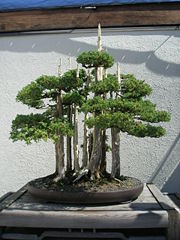
Goshin
Encyclopedia


Goshin is a bonsai
Bonsai
is a Japanese art form using miniature trees grown in containers. Similar practices exist in other cultures, including the Chinese tradition of penjing from which the art originated, and the miniature living landscapes of Vietnamese hòn non bộ...
created by John Y. Naka. It is a forest planting of eleven Foemina junipers (Juniperus chinensis
Juniperus chinensis
Juniperus chinensis grows as a shrub or tree with a very variable in shape, reaching 1-20 m tall. This native of northeast Asia grows in China, Mongolia, Japan, Korea and the southeast of Russia.-Growth:...
'Foemina'), the earliest of which Naka began training into bonsai in 1948. Naka donated it to the National Bonsai Foundation
National Bonsai Foundation
The National Bonsai Foundation is a nonprofit organization that was created to sustain the National Bonsai and Penjing Museum. NBF also helps the United States National Arboretum show the arts of Bonsai, and Penjing. The National Bonsai and Penjing Museum is located on the campus of the US...
in 1984, to be displayed at the United States National Arboretum
United States National Arboretum
The United States National Arboretum is an arboretum in Washington, D.C., operated by the United States Department of Agriculture's Agricultural Research Service as a division of the Henry A. Wallace Beltsville Agricultural Research Center...
; it has been there ever since. The individual trees represent Naka's grandchildren.
History
Naka began working with the first two of the eleven trees that would ultimately make up Goshin in 1948; he created a "two-tree style" composition using two Foeminia junipers of equal height. In 1953, Naka created a "formal upright" style Foeminia, during a demonstration for his bonsai class. He also acquired a taller tree (eventually to become the main, tallest tree of Goshin), which was replanted in the ground and gradually thinned and shaped; it was ready for showing by 1960.Goshin first took shape as a forest planting around 1964. Inspired by a forest of Cryptomeria japonica near a shrine in Japan, Naka first combined the four trees he had already developed into a single, 4 feet (1.2 m) composition. He soon added three more, to create a seven-tree forest bonsai. Naka also had to modify the pot to ensure adequate drainage—the lack of which caused one of the trees, and its repeated replacements, to die. At the time, Naka had seven grandchildren, each of which was represented by a tree. At the urging of fellow bonsai artists, he named his composition; he called the bonsai "Goshin", meaning "protector of the spirit", in reference to the forest shrine that inspired it. By 1973, Naka had eleven grandchildren, and he augmented Goshin concordantly.
In 1984, Goshin was displayed at the Philadelphia Flower Show
Philadelphia Flower Show
The Philadelphia International Flower Show is an annual event produced by The Pennsylvania Horticultural Society and held in Philadelphia, Pennsylvania at the Pennsylvania Convention Center in early March...
in mid-March, where it was viewed by about 250,000 people. At the show's conclusion, Naka donated Goshin to the National Bonsai Federation (which he had helped launch in 1976), to be displayed in the new North American Pavilion (named in his honor) of the National Bonsai & Penjing Museum at the United States National Arboretum
United States National Arboretum
The United States National Arboretum is an arboretum in Washington, D.C., operated by the United States Department of Agriculture's Agricultural Research Service as a division of the Henry A. Wallace Beltsville Agricultural Research Center...
in Washington, D.C.
Washington, D.C.
Washington, D.C., formally the District of Columbia and commonly referred to as Washington, "the District", or simply D.C., is the capital of the United States. On July 16, 1790, the United States Congress approved the creation of a permanent national capital as permitted by the U.S. Constitution....
Since 1984, Goshin has repeatedly graced the covers of prominent bonsai magazines, and it is one of the most widely recognized bonsai.
Naka returned frequently to Washington to check in on and supervise maintenance of Goshin, including extensive work in 1999. Later that year, he created another forest bonsai that is known as Goshin Two. When Naka died in 2004, one French site published a cartoon captioned (in translation): "John Naka has gone. A whisper of astonishment wanders in between the branches of Goshin."
External links
- North American Bonsai Federation – The History of Goshin
- The Phoenix Bonsai Society – Biography of John Yoshio Naka
- The Art of Bonsai Project – John Naka tribute gallery, including several photographs of Goshin

